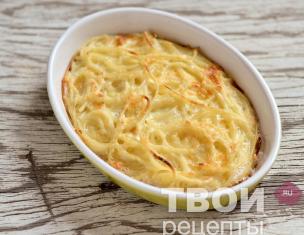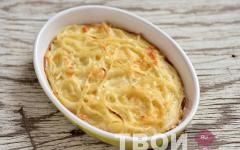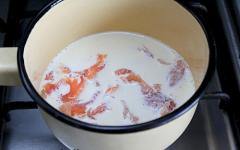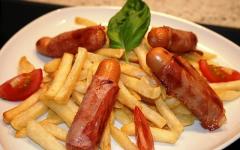As in many cities around the world, street food in Vienna is very diverse. These include Asian eateries, kebab stalls and market stalls with truly international cuisine.
But, perhaps, the greatest interest for tourists is the street food that you can. In other words, you can buy Chinese noodles in almost any European or Asian capital, but, for example, you can hardly eat the famous Vienna sausages anywhere else. Or at least no one guarantees that they will be as tasty as in Austria.
Popular street food in Vienna
Vienna sausages (Würstel)
Let's start our acquaintance with Vienna street food with the most popular street food - Vienna sausages. They are sold in special kiosks (German: Würstelstand - literally: “sausage stand”) and certainly with or wine:
- Käsekrainer(smoked minced pork sausage with cheese);
- Burenwurst(fried/boiled sausage with added bacon);
- Bratwurst(fried pork sausage);
- Sacherwürstel(smoked-boiled long and large sausages).
And this is not a complete list of items that you can try on the streets of Vienna.

The price of sausage (3.50€ -4.50€) usually includes bread and mustard as standard. Other street food add-ons (ketchup, curry sauce, pickles, etc.) cost 40-70 cents.
Würstel- This is a very satisfying, inexpensive and tasty street food; in Austria it is incredibly popular both among the residents of Vienna and among tourists. In the city center, “sausage stands” can be seen everywhere. The Bitzinger Würstelstand Albertina ( Address: Augustinerstrasse 1), Würstelstand Leo ( Doeblinger Guertel 2), Wiener Würstl ( Seilergasse 1).
Ham bun (Leberkäsesemmel)
Of course, this type of street food in Vienna cannot be called just a bun. If only because it doesn’t look much like a regular hamburger. Leberkäse is a special type of Austrian ham that is shaped like a loaf of bread. Slices of this “ham bread” are used as filling for Leberkäsesemmel. Usually they add mustard or other sauce to taste.

You can buy Leberkäsesemmel in almost every Würstelstand in Vienna. Such a bun costs from 2.60 €. And in a place called Leberkas-Pepi (Operngasse 12) you can try other original variations of this street food.
Schnitzel bun (Schnitzelsemmel)
As with Leberkäsesemmel, this Viennese street food is very reminiscent of a hamburger. True, the filling for it is not a cutlet, but a schnitzel.

Perhaps the schnitzel that is put in Schnitzelsemmel cannot be compared with what is served in. However, for street food, this is quite a tasty and filling snack option. The price of this type of street food starts from 3.20€. On the streets of Vienna you can try it with fresh vegetables (lettuce, tomatoes, onions), sauce or ketchup.
Baked chestnuts (Maroni)
Baked chestnuts are a popular Christmas delicacy, which, however, does not exclude the possibility of trying them at other times of the year.

Unusual street food in Vienna is sold in small paper bags - it seems to be created for leisurely and romantic walks around the Austrian capital. Depending on the size, Maroni bags cost from 2€ to 5€. They are sold at the so-called Maroni-Stände in Vienna (Walter & Mary’s Sommerstation am Wasserpark, beim Parkplatz and others).
Baked potatoes (Bratkartoffeln)
Appetizing circles of crispy baked potatoes with cheese, sour cream, onions, bacon, ham and other toppings - a typical street food in Vienna at Christmas.

This street delicacy is sold, as a rule, at the same “stand” as chestnuts, and also in small bags.
A little more about popular street food in Austria
If you have no prejudice against international cuisine, then the streets of Vienna will be a real find for you. Here you can easily find:
- pizza (it is sold by the portion, on triangular plates, for example, at Schwedenplatz);
- bourekas and falafel (say, at Brunnenmarkt);
- kebabs (the most famous are Berliner Döner);
- sandwiches (Mr Fly’s offers an amazing range);
- burritos (exclusively natural - at Wrapstars);
- and also, hamburgers, egg noodles and other dishes of Asian, American and European cuisine.
In addition to stands, kiosks and food trucks, Vienna has many permanent and seasonal food markets, where a wide variety of street food from all over the world is presented. The largest ones are organized on Christmas Eve.
For example, the Christmas Market on Rathausplatz brings together about 150 stalls, which, in addition to gifts and decorations, sell culinary delicacies, sweets and drinks: hot dogs, gingerbread, coconut punch, mulled wine, and much more.
Every year (usually in February, March, June), Vienna hosts grand street food festivals: Winter Food Festival, Street Food & Winter Market and others. If you're in Vienna during the event, don't miss the opportunity to try Austria's most popular and delicious street food.
Zhenya, can you send me the recipe? Particularly interested in the brine and subsequent heat treatment.
PASTEURIZED SAUSAGES
Technology
To prepare these canned foods, chilled beef and pork, back fat, shoulder fat or cheek fat are used.
Tendied beef and pork are ground on a grinder into pieces measuring 5-6 cm, then salted (per 100 kg of meat 1.8 kg of seasoned salt and 0.1 kg of saltpeter). Salted meat, each type separately, is placed in basins and transferred to a maturing chamber at a temperature of 4-6 ° C for 2-3 days.
Salted and ripened meat, as well as salted lard or cheek, are ground on a grinder (grid with holes 2 mm). The chopped beef is cut with the addition of finely choppedice, and in winter - cold (up to 8°C) water. Then the shredded pork is added to the cutter. Water is poured into the cutter gradually, and cutting continues until it is absorbed into the minced meat. During cutting, sugar and spices are added to the minced meat, and then chopped lard or cheek and the minced meat are cut until it becomes completely uniform in color and consistency.
Composition of minced meat (in kg per 100 kg):
Salted, trimmed beef. ....thirty
Trimmed pork............................................. 40
Salted bacon or cheek... ......30
Other materials added to minced meat (in kg per 100 kg of main raw materials):
Salt………………………………….1.8
Saltpeter………………………….…….0.1
Sugar........................................ 0, 1
Pepper
black.........................................0.1
red................................ . 0.05
Nutmeg ………………………….. 0,03
The minced meat mixed on the cutter is loaded into the syringe barrel and, using an automatic dispenser, lamb casings with a diameter of 18-20 and 20-22 mm are stuffed with it. The length of the sausages should correspond to the height of the cans.
Bunches of sausages are hung on and sticks for 15-30 minutes kept at a temperature of 20-25° C to compact the minced meat and dry the shell, then they are placed in a preheated smoking chamber. The smoking process is divided into three phases:
- phase - drying for 10-15 minutes over medium heat and a little smoke;
- phase - actual smoking for 25-35 minutes with low heat and a lot of smoke;
- phase - additional smoking at medium heat and a small amount of smoke.
The entire smoking process lasts about 60 minutes, The sausages turn light brown.
To ensure uniform smoking, you should rotate the frames or rearrange the sticks with sausages in the chamber during the process. Accumulating at the ends withdrops of water or fat must be removed before smoking or during smoking (wipe with clean towels). After smoking, the sausages are cooled to 18° C.
Before placing them in jars, separate the bars or pairs of them and sort out sausages with a burst casing, with air bubbles, unsmoked, with slips or contaminated.
Sausages are placed in jars in pairs or individual bars (under the lid of the jars, upright). The number and weight of sausages in jars are given in table. 82.
In jars measuring 99 X 177 mm, sausages are placed in two rows.
Sausages placed in jars are poured with a specially prepared brine with a strength of 2.5-3°B (temperature not exceeding 18°C). The brine is prepared at the rate of 3.2 kg of table salt per 10 liters of boiled water. Filled jars are sent for seaming.
Canned food is pasteurized immediately after seaming. In digesters, jars are installed upright. The pasteurization duration for different cans is as follows:

In the above descriptions of technological processes for canning sausages, three methods of sterilization are considered.
The first method is sterilization in a closed autoclave under pressure at a temperature of 112°C, the second method is double sterilization at a temperature of 100°C and the third method is pasteurization at a temperature of 100°C.
The last two methods produce sausages of better quality, approaching the taste of non-canned sausages. However, such sausages can only be stored under certain conditions: pasteurized - only at a temperature from 0 to 8 ° C, fractionally sterilized sausages - at a temperature not exceeding 15 ° C, shelf life no more than one year.
These restrictions cannot always be observed, especially when shipping canned sausages to the Far North. Sausages sterilized under pressure at 112°C can be stored at any temperature.
In the production of sausages, special attention should be paid to the quality of the casing. When the casing (lamb casings) arrives, it is necessary to carefully check its quality - strength, correct processing. The stuffing of minced meat into the intestinal casing should be loose so that the casing does not rupture during sterilization.
Recently, artificial casings - protein or cellophane - have been widely used to make sausages. Its advantage is its tensile strength. In addition, the use of an artificial casing dramatically increases the performance of the syringes.
When frying and boiling sausages in a cellophane casing, the top layer of minced meat (under the casing itself) becomes somewhat denser and, when the artificial casing is removed, seems to replace it. In terms of quality, sausages in an artificial cellophane casing are not inferior to sausages in a natural intestinal casing.
For sausages, cellophane casings of the following diameters are used: 20, 22, 24, 26, 28 and 30 mm; the bundles are made 20 and 10 m long. For injection, the sheath is completely put on the shank of the syringe. Stuffing minced meat into the casing is done manually or mechanically.
When stuffing minced meat by hand, the work table and the hands of the stuffers must be dry. A cellophane shell is put on a 40-long lantern cm also in dry condition. The diameter of the lantern should be severalmillimeters less than the diameter of the shell.
The minced meat is tightly stuffed into the casing in order to prevent air from getting into it and to make it possible to unscrew sausages of a certain length. After injection, the sausages are manually unscrewed into individual bars. The direction of unscrewing alternates: once - to the left, the other - to the right. When unscrewed, the sausages are placed in the form of a necklace so that they can be easily hung on a stick.
When mechanically stuffing minced meat using a syringe with a dispenser, the cellophane shell is pre-soaked in hot water for 30 minutes.
Before putting the shell on the tarsus, the latter is freed from air. The length of the shank is 50 cm, which allows you to pull a 20 m long casing onto it at a time. One end of the shell is tied, and the other remains free.
The untwisted sausages are placed on the work table in a zigzag pattern, two sausages at a time, to avoid unwinding. A stick is threaded through the bundles so that when hung, two sausages face down. With this arrangement of sausages, sticks do not form during frying. Sausages on frames are placed in frying chambers for drying and frying.
During frying, as mentioned above, a crust is formed under the artificial shell, the strength of which depends on the duration and temperature of frying. At a low frying temperature, this crust will be softer and thinner, which is especially important when producing canned sausages in jars.
Fried and smoked sausages are transferred for cooking in a boiler or steam chamber. After cooking, they are immediately cooled in the shower to prevent wrinkles and weight loss.
It is recommended to remove the casings from wet sausages immediately after cooling in the shower. In this form, the shell can be easily removed. After placing the sausages in the jars, 2-3% brine is poured into the jars.
Sausages in a cellophane casing are heat-resistant and do not burst when heated to 125°C. Sausages with the casing removed do not lose their shape when heated to PO-115°C. A clean cellophane casing does not contain any bacteria, it is practically sterile, therefore, when canning sausages made in it, the formation of bombing, which is possible when canning sausages in a natural intestinal casing, is excluded.
Sausages produced in an artificial casing can be preserved either with or without the casing.
Sterilization of sausages in a cellophane casing is carried out either in open boilers at a temperature of 98 ° C, or in autoclaves under pressure. When using open boilers, it is recommended to carry out double sterilization - the second cooking is carried out after cooling after 24-481Vienna sausage
Finely chop 2 kg of beef and 1.2 kg of pork, discarding the veins, and place on a sieve for 24 hours; Chop 1.2 kg of top lard into pieces, add 50 g of salt and leave for several hours. Having mixed everything together, add 120 g of salt, 40 g of cardamom and 50 g of plain pepper, stuff the intestines tightly, pierce with a thick needle or fork on all sides and hang in a draft wind for 3 days, then smoke for 2 weeks over coriander branches and juniper.
From the book Smoking, drying, salting, baking author Babkova Olga ViktorovnaHot sausage Ingredients: 500 g lean pork, 500 g veal, 300 g lard, 200 g intestines, 2-3 cloves of garlic, 10 black peppercorns, 1 g saltpeter, 20 g salt. Wash pork and veal, dry, chop finely, sprinkle with salt and peppercorns, add saltpeter, mix and
From the book Great Culinary Dictionary by Dumas AlexanderKnokworst sausage Ingredients: 1 kg of lean pork, 200 g of beef, 400 g of fatty pork (with lard), 200 g of pork intestines, 1 g of saltpeter, 2 g of anise, 4 g of ground black pepper, 20 g of salt. Rinse the pork and beef, cut in small pieces. Rinse the intestines thoroughly and dry. Add to meat
From the book How to make sausages at home author Kalinina AlinaFrankfurt sausage Ingredients: 1 kg of lean pork, 500 g of pork peritoneum, 200 g of pork with lard, 150 g of veal, 200 g of small intestines, 3 g of allspice, 15–20 g of salt. Rinse the pork and chop finely. Wash the veal and chop. Mix pork and veal, add salt,
From the book Smokehouse. 1000 miracle recipes author Kashin Sergey PavlovichLean sausage Ingredients: 700 g lean beef, 300 g fish fillet, 200 g small intestines, cardamom to taste, 2 g ground red pepper, 15 g salt. Rinse the beef and chop finely. Wash the fish fillet, chop finely and mix with salt, pepper and cardamom. Everything is thorough
From the book Ukrainian, Belarusian, Moldavian cuisines author Pominova Ksenia AnatolyevnaFrench sausage Ingredients: 500 g beef, 500 g pork, 250 g bacon, 400 g intestines 45–50 cm long, 1.5–2 g saltpeter, 25 ml alcohol or cognac, 10 allspice peas, 3 g nutmeg , 3 bay leaves, 2 g sugar, 35–40 g salt. Peel beef and pork from tendons and
From the author's bookHam sausage Ingredients: 1 kg of pork with fat, 100 g of intestines, 2 g of saltpeter, 5 g of pepper, 15 g of salt. Cut the meat into thin strips so that each strip has fat. Add a mixture of salt, pepper and nitrate, mix, leave for 12 hours under pressure, then stuff with minced meat
From the author's bookCountry-style sausage Ingredients: 4 kg of lean beef, 2.4 kg of fatty pork, 4 bay leaves, 400 g of large intestines, 10 allspice peas, 5 g of ground black pepper, 40 g of salt. Rinse the beef, cut into pieces and leave for 12 hours to let the blood drain, then skip
From the author's bookSAUSAGE Finely chopped meat stuffed into beef intestines. There are cities that owe their fame to their good sausages. There are sausages from Lyon, Strasbourg, sausages from Arles; but it must be admitted that the beauty of the Arlesian women glorified their city to an even greater extent than their taste
From the author's bookHomemade sausage 4 kg lean beef, 3 kg backfat, 3 kg lean pork, 350 g salt, 20 g sugar, 0.75 g sodium nitrite, 5 g cumin, 3 g cardamom, 0.5 g glucose, pork casings . Skip meat and bacon that have been frozen in the refrigerator in advance.
From the author's bookTea sausage 7 kg lean pork, 3 kg back fat, 300 g salt, 0.75 g sodium nitrite, 10 g ground white pepper, 5 g dry mustard, 5 g sweet pepper, pork casings. Pass the pre-cooled pork and lard through a meat grinder (4 mm holes) and
From the author's bookSausage “Hermit” 1 kg of lean beef (from the rump), 1 kg of lean pork (from the hip), 500 g of high-quality back fat (without skin), 3 tbsp. spoons with the top of the mixture for salting, 1 teaspoon with the top of glucose, 2 tbsp. level spoons ground white pepper,
From the author's bookBiodietary sausage 250 g veal, 250 g poultry, 250 g hare meat, 125 g lean beef, 125 g lean pork, 1 tbsp. spoon of dietary salt, 1 tbsp. a spoonful of milk, 2 teaspoons without top of ground white pepper, 1 teaspoon of sugar. All meat components 2 times
From the author's bookFrench sausage 0.5 kg of fatty and low-fat pork, 1 onion, 1 teaspoon of salt, pinch of pepper, 1 teaspoon of cumin, 2 tbsp. spoons of mashed dry bread, 1 tbsp. spoon of rum, sheep intestines. Finely chop the meat. Add 1 onion, 1 teaspoon salt, a pinch of pepper,
From the author's bookHungarian sausage 0.8 kg of young, not very fatty pork, 1 teaspoon of salt, a pinch of pepper, ginger, nutmeg, cloves, 1 bun, beer. Add to the meat 1 teaspoon of salt, a pinch of pepper, ginger, nutmeg, cloves, 1 French toast soaked in beer
From the author's bookPork sausage “Vienna” Ingredients 3 kg of fatty pork, 2 kg of lean beef, 2 eggs, 3 cloves of garlic, ground black pepper, salt. Method of preparation Finely chop the beef, mince the pork. Salt the meat and leave in the cold for 12 hours, then
From the author's bookSausage Ingredients: 1 kg of pork, 100 g of lard, 1 head of garlic, cumin, ground black pepper, salt. Method of preparation Wash the pork, cut it, mince it. Peel the garlic and chop using a garlic press. Mix the resulting minced meat with garlic,
On June 11-12, 2012, a Vienna sausage festival will be held in Hasseldorf. One of the world's most famous master sausage products turns 207 years old. The anniversary of "Wiener Wurstchen" will be celebrated in both Austria and Germany.
The recipe for Vienna sausage - "Wiener Wurstchen" - was developed by master Johan Georg Laner, who was born on August 13, 1772 in the German town of Hasseldorf. When the time came to choose a profession, Laner became a pupil of a butcher in Frankfurt am Main. In addition to other delicacies, he learned how to make delicious pork sausages. At that time, in Germany it was forbidden to mix different types of minced meat - it was this tradition, enshrined in the old laws, that Laner later broke.
Creative sausage maker
When the training was completed, the young butcher from Germany moved to Vienna, where he founded his own production. Austria had the most liberal shop rules. While working on creating branded products, Laner began experimenting with recipes that were brought from Frankfurt. One day he came up with the idea of adding a little beef to the meat mixture for the Frankfurt pork sausage. After that, he included some coarsely chopped bread in the recipe, and also came up with his own spice mixture. So in 1805, a new product appeared in Laner’s shop, which the master called “Frankfurt Vienna sausage.” Later, the first part disappeared, most likely due to his clients who were too lazy to pronounce such a long name. Finally, Frankfurt and Vienna sausages are similar in appearance, the only difference is in the recipe.
Even Kaiser Franz the First once declared Frankfurt Vienna sausage as his favorite dish. In 1855, it was delivered from Vienna on special courier carts to the World Exhibition in Paris.
Original and "fake"
Together with immigrants from Europe, Frankfurt and Vienna sausages even penetrated overseas - to America, where they became part of the famous hot dogs. Vienna sausage is currently more widespread throughout the world than its Frankfurt - purely pork - relative. According to one of the regulations of the European Union, designed to protect the name of regional delicacies, only sausages made according to the classic recipe in this German town are called “original Frankfurt”. It would not be amiss to note that, according to historical testimony, Frankfurt pork sausage was first served to guests in one of the inns in 1280.
Vienna patent
Today Vienna sausage can be produced everywhere, although since 2003 there has been a small restriction. The authorities of the German town of Gasseldorf have patented the product “Original Vienna sausage according to Laner’s recipe”, having received the corresponding certificate number 30429127. However, it does not apply to “non-original” and “copies” sausages.
The only German food that immediately comes to mind for any bro is always pork knuckle and sausages with cabbage. In fact, this is practically all German cuisine, because no one is interested in anything else. Only there are more than 1,500 types of German sausages, dude, for all occasions. Since there is no better beer food than German sausages (and don’t argue!), today we will tell you about them
Vienna sausages
Their German name is Wieners. These sausages are usually served boiled. Despite the name, this is not Austrian food, but German. Traditional Vienna sausages contain 91 percent pork, which is a must. The minced meat is cooked together with lard, spices and ice, this makes the sausages especially tender. The correct, truly German way of cooking sausages is not to boil them, but to pour boiling water over them for 5 minutes and cover with a lid. In Germany there is a rather nice tradition: if the buyer is with a child, then the child is supposed to be given a Vienna sausage. That's why they are also called children's.
Bockwurst
This is also a sausage. It is half pork and half beef sausage. They are also not boiled: instead, a true German brings the water to a boil, reduces the heat to the very minimum, puts the bockwurst in and cooks for 15 minutes over low heat, making sure that the water does not start to boil. The shelf life of such sausages is 3 days. Well, like the expiration date, the expiration date, after that they lose their taste and turn into just sausages.

Bratwurst
Bratwurst is a sausage that is fried. Sometimes they are sold raw, and sometimes already boiled, but the correct bratwurst is the one that is raw. It resembles an intestine with minced meat inside. At first glance, it doesn't look too appetizing, but it's worth it. Sausages are fried after pouring boiling water over them, if they are raw. Bubbles that appear during frying are pierced with a fork.

Currywurst
Sausages with curry powder. The curry is combined with tomato paste, and the sausages are poured with this mixture. The dish is served with potatoes and bread. They are considered traditional German food, although they appeared relatively recently - after the Second World War. Workers rebuilding German cities had lunch, breakfast and dinner in the stalls where this food was served. Since then, curry sausages have become a “folk food”.

Weiswurst.
“White sausage” is the exact translation from German. They are made from veal and pork mixed with crushed ice. Chopped fresh parsley must be added to the minced meat. Sausages are cooked in the same way as bratwurst - in non-boiling water. Sometimes white wine or vinegar is added to the water. Served exclusively with sweet mustard.

But what about sausages without traditional cabbage? It must be done correctly!
So, for a full evening with beer, good sausages and your loved one you will need:
1/2 kg. sauerkraut (juice must be squeezed out).
- 1/2 l. water.
- 1 onion, diced.
- 1 hefty raw potato, grated.
- 1 clove of garlic.
- 3 tbsp. l. vegetable oil.
- black peppercorns.
- 1 bay leaf.
- salt, pepper to taste.
Fry the onion until golden brown. Place the cabbage, pepper it, add salt, and add bay leaves on top. Fill all this with water and simmer for about half an hour under the lid.
Then remove the lid, pour in the potatoes, add some water and simmer for another half hour until the liquid has completely evaporated.
Here's some traditional German food *there must be some German words here*.










